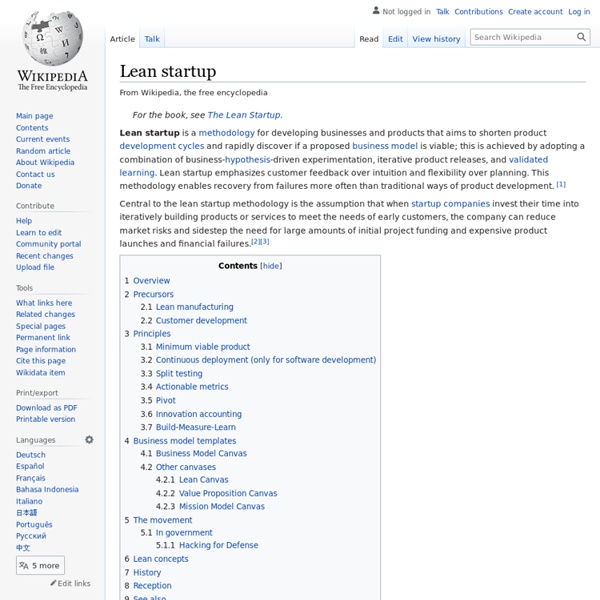The Customer Value Map v.0.8 – now called Value Proposition Canvas
I've been thinking about "plug-ins" that complement the Business Model Canvas for a while. One concept that I've been looking at more closely over the last few weeks is the invaluable "jobs-to-be-done" approach. I tried to turn it into a visual approach like the Business Model Canvas (BMC). The result is a prototype conceptual tool, the Customer Value Canvas Map v.0.8. now called Value Proposition Canvas. Update: the final outcome of the Value Proposition Canvas can be found in this post.
Here's What The Average Tech Startup Looks Like
Between reading GeekWire every day, watching the Tech Stars Seattle Demo Day pitches, seeing the latest infographic from Gist, talking to Angels and VCs, and discussions with fellow venture backed entrepeneurs, I have lately been wondering what the “average” tech startup looks like today. It is a lot smaller than I had thought. To help answer this question, I turned to the detailed information published on the Tech Stars web site.
Startup company
Evolution of a startup company[edit] Startup companies can come in all forms and sizes. A critical task in setting up a business is to conduct research in order to validate, assess and develop the ideas or business concepts in addition to opportunities to establish further and deeper understanding on the ideas or business concepts as well as their commercial potential.
Viral marketing is not a marketing strategy
Many times, viral marketing is seen as a “marketing strategy” that is interchangeable with other methods of acquiring users. That is, you go through three steps: Develop your productThink through a plan on how to make people use itDeclare viral marketing is one of N approaches (along with SEO, SEM, PR, etc.) Or perhaps you already have an existing product, and you have gotten interested in using a Facebook widget or something like that to make it “viral.” If you are in this boat and think of viral marketing as a compelling marketing strategy, you’re in trouble.
Angel investor
An angel Investor or angel (also known as a business angel or informal investor) is an affluent individual who provides capital for a business start-up, usually in exchange for convertible debt or ownership equity. A small but increasing number of angel investors organize themselves into angel groups or angel networks to share research and pool their investment capital, as well as to provide advice to their portfolio companies.[1] Etymology and origin[edit] The term "angel" originally comes from Broadway, where it was used to describe wealthy individuals who provided money for theatrical productions. In 1978, William Wetzel,[2] then a professor at the University of New Hampshire and founder of its Center for Venture Research, completed a pioneering study on how entrepreneurs raised seed capital in the USA, and he began using the term "angel" to describe the investors that supported them. Source and extent of funding[edit]
Jobs-To-Be-Done Theory And Framework
Jobs-To-Be-Done Framework For Marketing Appealing to emotion and function When marketing is examined through a jobs-to-be-done lens, it becomes apparent that the goal of marketing is to inform customers of a company's ability to help them get a job done better. Strategyn knows that customers have both functional and emotional jobs they are trying to get done. Marketing a product around its functional benefits and around the factors that bring it emotional appeal is the key to an effective product positioning strategy. This is part of our jobs-to-be-done methodology.
Agile software development
Agile software development is a set of principles for software development in which requirements and solutions evolve through collaboration between self-organizing,[1] cross-functional teams. It promotes adaptive planning, evolutionary development, early delivery, and continuous improvement, and it encourages rapid and flexible response to change.[2] Agile itself has never defined any specific methods to achieve this, but many have grown up as a result and have been recognized as being 'Agile'. The Manifesto for Agile Software Development,[3] also known as the Agile Manifesto, was first proclaimed in 2001, after "agile methodology" was originally introduced in the late 1980s and early 1990s. The manifesto came out of the DSDM Consortium in 1994, although its roots go back to the mid 1980s at DuPont and texts by James Martin[4] and James Kerr et al.[5] History[edit]
.NET
.NET Framework (pronounced dot net) is a software framework developed by Microsoft that runs primarily on Microsoft Windows. It includes a large library and provides language interoperability (each language can use code written in other languages) across several programming languages. Programs written for .NET Framework execute in a software environment (as contrasted to hardware environment), known as the Common Language Runtime (CLR), an application virtual machine that provides services such as security, memory management, and exception handling.
How to design your Business Model as a Lean Startup
If you spend time exploring innovation frameworks, you know that configuration of such frameworks largely apply, assembly, and build upon previous work (hat off to science). I have come to explore conformity of two emerging frameworks; the Business Model Ontology by Alex Osterwalder and the Lean Startup methodology by Eric Ries. The result, the Lean Startup and Business Model Canvas pattern is illustrated below.



